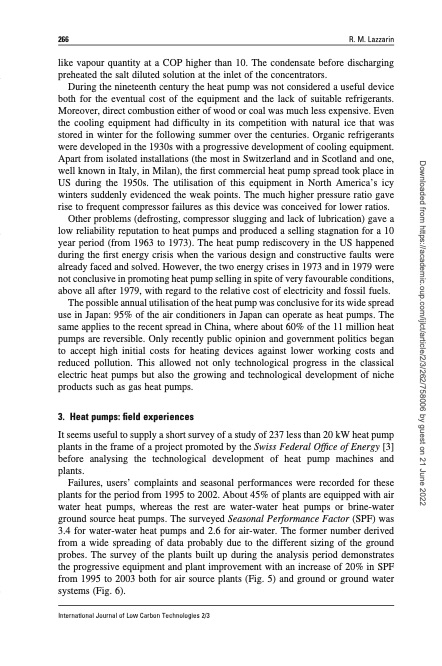
PDF Publication Title:
Text from PDF Page: 005
266 R. M. Lazzarin like vapour quantity at a COP higher than 10. The condensate before discharging preheated the salt diluted solution at the inlet of the concentrators. During the nineteenth century the heat pump was not considered a useful device both for the eventual cost of the equipment and the lack of suitable refrigerants. Moreover, direct combustion either of wood or coal was much less expensive. Even the cooling equipment had difficulty in its competition with natural ice that was stored in winter for the following summer over the centuries. Organic refrigerants were developed in the 1930s with a progressive development of cooling equipment. Apart from isolated installations (the most in Switzerland and in Scotland and one, well known in Italy, in Milan), the first commercial heat pump spread took place in US during the 1950s. The utilisation of this equipment in North America’s icy winters suddenly evidenced the weak points. The much higher pressure ratio gave rise to frequent compressor failures as this device was conceived for lower ratios. Other problems (defrosting, compressor slugging and lack of lubrication) gave a low reliability reputation to heat pumps and produced a selling stagnation for a 10 year period (from 1963 to 1973). The heat pump rediscovery in the US happened during the first energy crisis when the various design and constructive faults were already faced and solved. However, the two energy crises in 1973 and in 1979 were not conclusive in promoting heat pump selling in spite of very favourable conditions, above all after 1979, with regard to the relative cost of electricity and fossil fuels. The possible annual utilisation of the heat pump was conclusive for its wide spread use in Japan: 95% of the air conditioners in Japan can operate as heat pumps. The same applies to the recent spread in China, where about 60% of the 11 million heat pumps are reversible. Only recently public opinion and government politics began to accept high initial costs for heating devices against lower working costs and reduced pollution. This allowed not only technological progress in the classical electric heat pumps but also the growing and technological development of niche products such as gas heat pumps. 3. Heat pumps: field experiences It seems useful to supply a short survey of a study of 237 less than 20 kW heat pump plants in the frame of a project promoted by the Swiss Federal Office of Energy [3] before analysing the technological development of heat pump machines and plants. Failures, users’ complaints and seasonal performances were recorded for these plants for the period from 1995 to 2002. About 45% of plants are equipped with air water heat pumps, whereas the rest are water-water heat pumps or brine-water ground source heat pumps. The surveyed Seasonal Performance Factor (SPF) was 3.4 for water-water heat pumps and 2.6 for air-water. The former number derived from a wide spreading of data probably due to the different sizing of the ground probes. The survey of the plants built up during the analysis period demonstrates the progressive equipment and plant improvement with an increase of 20% in SPF from 1995 to 2003 both for air source plants (Fig. 5) and ground or ground water systems (Fig. 6). Downloaded from https://academic.oup.com/ijlct/article/2/3/262/758006 by guest on 21 June 2022 International Journal of Low Carbon Technologies 2/3PDF Image | Technological innovations in heat pump systems

PDF Search Title:
Technological innovations in heat pump systemsOriginal File Name Searched:
2-3-262.pdfDIY PDF Search: Google It | Yahoo | Bing
CO2 Organic Rankine Cycle Experimenter Platform The supercritical CO2 phase change system is both a heat pump and organic rankine cycle which can be used for those purposes and as a supercritical extractor for advanced subcritical and supercritical extraction technology. Uses include producing nanoparticles, precious metal CO2 extraction, lithium battery recycling, and other applications... More Info
Heat Pumps CO2 ORC Heat Pump System Platform More Info
| CONTACT TEL: 608-238-6001 Email: greg@infinityturbine.com | RSS | AMP |